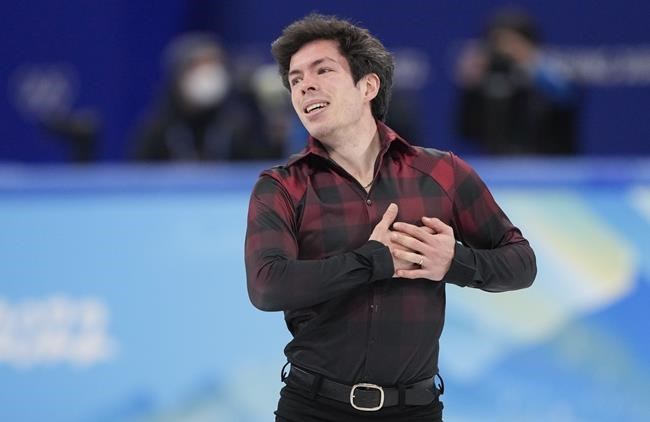MISSISSAUGA, Ont. — The quadruple Axel is a love/hate thing for Canadian figure skater Keegan Messing.
"I see it — and I just want to quit," he said, with a laugh.
Messing once dreamed about being history's first to land the most difficult jump in figure skating, but the 30-year-old said age caught up with him.
And so he had mixed feelings when 17-year-old Ilia Malinin of the United States landed the first fully-rotated quad Axel in competition. He did it first at a lower-level U.S. event last month and then again at Skate America last weekend, where he won gold in his senior Grand Prix debut.
"I can't wait to see where the sport goes," Messing said. "It's definitely a love/hate relationship I have with the quad Axel, because I'm still competing, and I see it and it just makes me want to quit. But then to see someone able to do it, and what appears to be so effortless … unreal. Honestly, hats off to him. Congratulations."
Messing headlines the Canadian men's field at Skate Canada International this week, and while quadruple jumps have become must-haves in men's skating — American Nathan Chen landed five in his free program to win Olympic gold in Beijing — the quad Axel takes the sport to a completely new level.
Canada's Kurt Browning landed the first quad, a toeloop, in 1988, and since then skaters have mastered the quad flip, loop, Salchow and Lutz. But not the Axel, and it's been 44 years since Canadian Vern Taylor landed the first triple Axel.
Messing had been trying to master the elusive jump, both while wearing a harness — which looks like a giant fishing pole — and without.
"Actually I got pretty close. I got within a quarter (rotation) on it," Messing said. "It is such an unreal (feeling)."
Messing, who plans to retire after this season, said as he got older, injury concerns stopped him from pursuing the quad Axel.
That's part of why the jump has received mixed reviews. Three-time world champion Elvis Stojko made the quad jump his calling card, and has been thrilled about the proliferation of the four-revolution jumps. But even Stojko believes there's a fine line between pushing the sport and physically punishing the athlete, particularly when the big jumps favour a particular narrow-hips body type.
"The days of my body type are gone. Now you've got to be a twig, tall and thin," Stojko said in an interview Thursday. "But now longevity becomes the issue. We've seen that with (Japanese star Yuzuru) Hanyu with injury after injury after injury. How long can their bodies take that type of pounding?
"When I was competing, I was heavy at 153 pounds. That was kind of average-ish. Kurt (Browning) was about 140-something. Now the guys are like 116, 118 pounds. That's super light. In order to do those quads at that level, you can't be over 130 pounds … but then there's the pounding of it and the torque."
The quad Axel is actually four-and-a-half rotations, and the only jump where skaters take off facing forward and land backwards.
"It's the one jump where you can't cheat it on the takeoff or on the landing, it's a true four-and-a-half," said Skate Canada's high performance director Mike Slipchuk, who competed in men's singles in the '92 Olympics.
Skaters land quads with the force of seven times the body weight, on a blade barely thicker than a toonie. And the forward-facing takeoff makes the Axel a recipe for disaster.
"If you're short on the landing, Axels kill you," Stojko said. "I used to snap blades on the landings of Axels that came up short. And because you take off forward, if you're under-rotated, a lot of times you (come down) facing forward, and oh my god."
"It’s the one jump you lose sense in the air," Slipchuk added. "You can come out of the Axel and not have a clue where you are."
Steven Gogolev has watched the video of Malinin's quad Axel several times, and said he figured if anyone was going to land it, it would be the young American whose Instagram handle is @quadg0d.
"Because he has really good Axel technique," Gogolev said.
Gogolev, who's also competing at Skate Canada this week, became the first Canadian to land three different quads in a program when he was only 13, and five foot two. He's since sprouted to six feet, a rapid growth spurt that took some adjustment.
He believes the emergence of the quad Axel is good for the sport.
"And I wouldn't say skaters will be pressured to learn it, I think we'll be more motivated to," Gogolev said.
Despite the different views on the jump, there was at least consensus on Malinin's execution of it.
Textbook.
"You'd think maybe the first quad Axel will be a squeaker. But it's not," Slipchuk said.
To which Stojko added with a laugh: "It's a swisher."
Skate Canada International begins Friday at Paramount Fine Foods Centre. It's the second event on the ISU Grand Prix circuit that culminates with the Grand Prix Final in Turin, Italy in December.
This report by The Canadian Press was first published Oct. 27, 2022.
Lori Ewing, The Canadian Press



